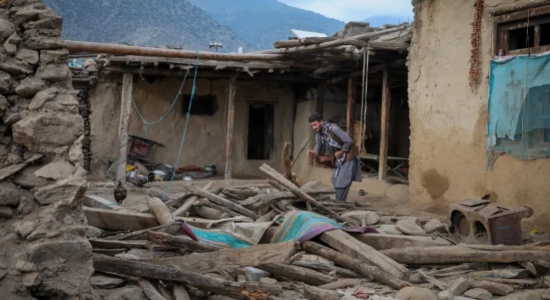An earthquake in eastern Afghanistan late Sunday night devastated Kunar and surrounding areas. According to Taliban government spokesman Zabihullah Mujahid, so far at least 1,411 people have died and 3,124 people have been injured in this devastating earthquake. Along with this, 5,412 houses were completely destroyed due to the intensity of the earthquake.
Earthquake in Afghanistan: information
According to the US Geological Survey (USGS), this earthquake was of magnitude 6.0, with a depth of about 8 kilometers (5 miles). The day before this, another earthquake was recorded as magnitude 5.2. Afghanistan falls in an earthquake prone zone due to its location at the confluence of the Indian and European plates, due to which devastating earthquakes often occur here.
Difficulty in relief work
Kunar’s disaster management chief Ehsanullah Ehsan said that it is extremely difficult to carry out relief work in earthquake-affected mountainous areas. “We cannot say how many people are still trapped under the rubble. Our effort is to start relief distribution as quickly as possible,” he said.

The earthquake has damaged roads and in many places landslides and falling rocks have completely blocked the roads. That is why relief teams have to rely on helicopters.
Struggles of local people
Local people are also engaged in rescuing people trapped under the rubble. Obaidullah Stoman, 26, from Wadir village in Kunar’s Nugral district told AFP news agency, “I came here to look for my friend, but there is only rubble left here. It was very difficult for me to see the situation.”
Akhlaq, 14, who was brought to hospital with injuries, said five members of his family were buried under the rubble. “The whole house collapsed. Only I survived and could take out my father. There are still many people trapped under the rubble, but there is no one to rescue them.”
International help
Several international organizations are engaged in relief work in the earthquake-affected areas. The United Nations, the International Red Cross and Red Crescent Societies, and the World Health Organization (WHO) are working to provide health services and relief supplies to the affected areas.
The UK has provided 1 million pounds (about $1.35 million) to distribute health and emergency supplies through the UN and the Red Cross. “This emergency aid will help get health and emergency supplies to those most affected,” British Foreign Secretary David Lammy said.
India has sent 1,000 family tents to Kabul and 15 tonnes of food to Kunar, with more relief supplies on the way. The European Union has announced 130 tonnes of emergency supplies and 1 million euros (about $1.16 million) in aid.
Health and infrastructure situation
The WHO warned that Afghanistan’s health system was fragile even before the earthquake and is now completely unable to respond. “The roads and distances make it very difficult to deliver relief supplies. Local health facilities are now completely dependent on external help.”
Despite international help, relief work has become “almost impossible” as debris and road damage prevent equipment and relief workers from reaching the most remote villages.
Future challenges
The number of people trapped in the rubble is not yet clear. Afghan authorities and international organizations are warning that the death toll could rise further. Relief and rehabilitation work will continue for the next several weeks.
Afghanistan has experienced several devastating earthquakes in the past few decades. In October 2023, an earthquake in the western province of Harat killed more than 2,000 people.
This earthquake in eastern Afghanistan has not only proved devastating to life and property, but it is also bringing forth serious challenges to relief and rehabilitation work. Local people, administration and international organizations are working together, but the work is extremely difficult due to difficult geography and damaged infrastructure.







